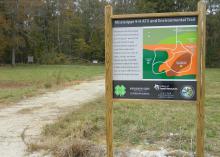Information Possibly Outdated
The information presented on this page was originally released on September 9, 2016. It may not be outdated, but please search our site for more current information. If you plan to quote or reference this information in a publication, please check with the Extension specialist or author before proceeding.
Off-road vehicles bring fun, hazards
STARKVILLE, Miss. -- Speeding along a wooded trail on a bright, chilly morning can bring a lot of enjoyment and excitement. And it sure is a lot easier getting to that back-country deer blind or dove field if you can load up all the gear and head off on wheels.
But the off-road vehicle you may be riding -- whether a 4x4 all-terrain vehicle, side-by-side utility vehicle or dirt bike -- has some downsides. While undeniably fun and useful in transportation, an off-road vehicle can also be an environmental hazard and personal nuisance when used incorrectly.
Like many things in life, use of these vehicles can be both positive and negative. With some background facts, people can make smart choices that minimize their negative impact on the environment.
Here are some simple, common sense rules to protect land, water and wildlife. Many streams and rivers are protected by state law, even when they flow through private land. Although it may be fun to follow the meanders of a stream on a four-wheeler, especially during steamy summer months, it is also illegal. Off-road vehicle tires grind up the bottom of the creek or river, crushing the small animals that live there and destroying their habitat. These creatures support populations of larger fish, so things that negatively affect the bottom of the food chain will also be harmful to wildlife further up the food chain. Off-road vehicles are prohibited in wetlands, streams or lakes on state-owned land, such as wildlife management areas.
Keep off-road vehicles out of stream channels and off steep banks. Cross slowly at designated fording locations to reduce damaging the stream bottom and causing down-stream sedimentation. Oil and gasoline residues that wash off these vehicles can reduce water quality and harm aquatic life, so try to cross when water levels are low.
Ride on designated trails and keep to the middle so the trail doesn’t get wider over time. Use trails when they are dry and stable. Muddy trails may be fun, but they are easily destroyed, ruining others’ fun and increasing erosion. If you must ride on wet trails, reduce the throttle and use the clutch to gain traction and reduce wheel spin. Avoid gouging the trail by brake sliding or spinning out on corners.
Soil is lost not only in rainy conditions, but also in dry and windy situations. Remember the dust plume following your vehicle, especially if others are around, and adjust to a slower speed.
Be alert to wildlife and respect their space. Give them the right-of-way, and don’t chase or harass the animals.
Be sensitive to hikers, campers, sportsmen and landowners. Off-road vehicles are noisy and fast. They can ruin a quiet, natural experience for others.
Research also has shown off-road vehicle tires can distribute seeds, including those of weeds or invasive plants. To prevent the spread of noxious plants, rinse off the vehicles after use.
Carry your trash out with you. Pick up litter left behind by thoughtless visitors.
Turn off the machine rather than letting it idle to reduce air pollution and conserve fuel.
With a little thought and planning, off-road vehicle use will remain an option in the future if riders practice good environmental stewardship. Spread the word, and go to http://extension.msstate.edu for more information on ATV use and safety.

Editor’s Note: Extension Outdoors is a column authored by several different experts in the Mississippi State University Extension Service.









